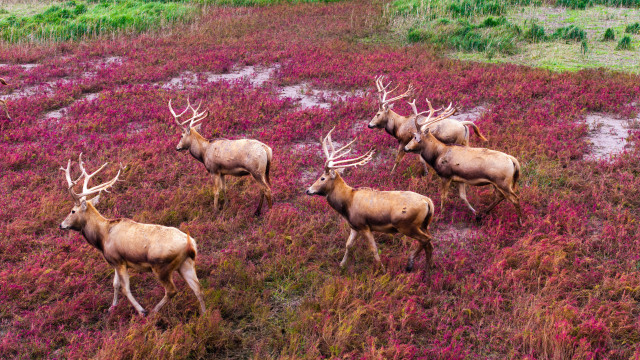






























See Also
See Again
© Getty Images
0 / 31 Fotos
The art of living together
- Our planet is home to millions of species, and quite probably more! These diverse species often share the same spaces and resources, leading to a variety of interactions, known as symbiosis.
© Getty Images
1 / 31 Fotos
The art of living together
- Our symbiotic relationship with nature isn’t just a poetic idea; it’s a profound reality we can’t afford to ignore. We depend on the Earth’s ecosystems for the air we breathe, the water we drink, and the food we eat. We are intrinsically linked to nature’s cycles, from the changing seasons to the tides that shape our coastlines.
© Getty Images
2 / 31 Fotos
The importance of biodiversity
- Our interdependence with nature runs deeper than we think. Nature’s intricate ecosystems and delicate balance are crucial for our future. Biodiversity, the variety of life on Earth, is not just a measure of beauty; it’s the foundation of resilience.
© Getty Images
3 / 31 Fotos
Competition and cooperation
- Life competes for various natural resources—food, light, water, and shelter. However, competition is just one part of the story; cooperation and mutual benefit are also at the heart of countless interactions in nature.
© Getty Images
4 / 31 Fotos
The essence of symbiosis
- The term symbiosis comes from Greek, meaning "living together." Ecologists use it to describe various interactions between species and divide it into three categories.
© Getty Images
5 / 31 Fotos
Parasites
- Parasitism is where one organism feeds on another, without necessarily killing the host. In the ocean it involves organisms like nematodes, leeches, and barnacles feeding on their hosts. Unlike predators, these parasites often remain with their hosts, which may eventually become sick and die over time.
© Getty Images
6 / 31 Fotos
Commensalism
- In a commensalism symbiotic relationship, one organism benefits from another by using them for food, shelter, or transport without causing harm or providing help. Smaller commensal species usually benefits from a larger host without altering it, and while the host remains unchanged, the commensal may exhibit significant morphological adaptations.
© Getty Images
7 / 31 Fotos
Mutualism
- Mutualism is when both organisms benefit from their interaction. Often referred to as symbiosis in popular usage, mutualistic relationships are key to thriving ecosystems. Let’s delve into these beneficial partnerships and their essential role in different ecosystems.
© Getty Images
8 / 31 Fotos
Lichens: nature's symbiotic wonders
- Lichens are fascinating organisms that form the backbone of many ecosystems. They consist of a fungus and an alga, and sometimes a cyanobacterium joins the mix.
© Getty Images
9 / 31 Fotos
Lichens: nature's symbiotic wonders
- The fungus provides structure, while the alga generates energy through photosynthesis. This tight-knit alliance, known as endosymbiosis, means that one organism lives inside the cells or body of another.
© Getty Images
10 / 31 Fotos
Lichens: nature's symbiotic wonders
- Map lichen is a crust-like species found growing on rocks. This remarkable organism secretes acids that can dissolve rock, kickstarting soil formation. Lichens create a substrate for other plants to grow on and often serve as habitats for tiny mites, spiders, and other invertebrates.
© Getty Images
11 / 31 Fotos
Mycorrhizas: forest's hidden partners
- Fungi are vital yet often overlooked contributors to forest ecosystems. Mycorrhizas are symbiotic relationships between certain fungi and plant roots. The fine fungal threads, known as hyphae, wrap around or penetrate the roots of host plants, fostering mutual benefits.
© Getty Images
12 / 31 Fotos
Mycorrhizas: forest's hidden partners
- In mycorrhizal relationships, the fungus aids the plant in extracting nutrients and water from the soil while shielding it from harmful organisms. In return, the fungus receives sugars produced by the plant through photosynthesis. As with most mutualistic relationships, both partners thrive better together than they would alone.
© Getty Images
13 / 31 Fotos
Mycorrhizas: forest's hidden partners
- Birch trees form notable partnerships with fungi, such as the iconic red-with-white-spots fly agaric. Scots pine, on the other hand, has mycorrhizal associations with over 200 fungal species in Scotland. In fact, mycorrhizas were crucial in helping plants colonize land millions of years ago!
© Getty Images
14 / 31 Fotos
The engine of evolution
- Many scientists believe that significant evolutionary leaps were sparked by symbiosis. Plant and animal cells contain organelles—structures that perform specialized functions within the cell. These organelles evolved from endosymbiotic relationships, where one bacterium lived inside another cell.
© Getty Images
15 / 31 Fotos
Nature’s photosynthesis
- Chloroplasts, key organelles in plant cells, are responsible for photosynthesis. They evolved from cyanobacteria, primitive bacteria capable of photosynthesis. Observing the green tapestry around us, we can appreciate the vast scale on which symbiosis has shaped forest ecosystems.
© Getty Images
16 / 31 Fotos
Soil enrichers
- Symbiosis operates on various scales, such as the relationship between alder trees and the bacterium Frankia alni. Frankia resides inside nodules on alder roots, where it absorbs nitrogen from the atmosphere and fixes it in the soil, enriching the environment.
© Public Domain
17 / 31 Fotos
Soil enrichers
- This symbiotic relationship benefits the alder, which provides sugars to Frankia through photosynthesis. In turn, the bacteria enrich the soil by fixing atmospheric nitrogen. People have utilized alder trees in various regions worldwide to restore depleted soils, demonstrating the power of symbiosis.
© Getty Images
18 / 31 Fotos
Nature's digesters
- Ruminants are hoofed mammals that digest food in two stages, essential for their survival. Red deer and the now-extinct aurochs have a complex digestive system, relying on symbiotic relationships. After regurgitating food to chew as "cud", it then moves into one of their four stomach chambers.
© Getty Images
19 / 31 Fotos
Nature's digesters
- Bacteria help ruminants by breaking down indigestible cellulose in plant material, receiving glucose in return. This symbiosis produces volatile fatty acids, supplying energy to their host mammals.
© Getty Images
20 / 31 Fotos
Colorful partnership
- Pollination is a unique form of symbiosis that’s easy to observe. Flowers act as attractive advertisements to insects, offering energy-rich nectar. After feeding on the sugary liquid, the insect unknowingly carries pollen to fertilize other flowers, benefiting the overall population of that particular plant species.
© Getty Images
21 / 31 Fotos
Colorful partnership
- Pollination likely evolved as a response to early insects consuming pollen. Plants offering nectar as an alternative had a better chance of reproducing. This strategy spared the pollen, which was then carried from plant to plant. Insects continued to feed, allowing flowering plants to evolve and flourish.
© Getty Images
22 / 31 Fotos
Seed dispersal strategy
- Berries evolved to cope with animals feeding on their seeds, benefiting both parties. Birds and mammals gain a meal, while the plant’s seeds remain unharmed and are dispersed. Some seeds, like those of the rowan, are even "activated" by passing through an animal's digestive system.
© Getty Images
23 / 31 Fotos
Forest's tiny allies
- Wood ants form symbiotic relationships with various forest organisms. Some flowering plants rely on ants for seed dispersal, like cow-wheat seeds, which have fatty attachments. Ants carry these seeds to their nests, feed the fatty part to their larvae, and help disperse the plants.
© Getty Images
24 / 31 Fotos
Forest's tiny allies
- Wood ants also have a fascinating partnership with certain aphids. By stroking the aphids, ants stimulate them to release honeydew, a sweet liquid that serves as a meal for the ants. In return, the aphids receive protection from predators and competing sapsuckers, thanks to their ant guardians!
© Getty Images
25 / 31 Fotos
Unlikely alliance
- Ravens and wolves share a fascinating relationship. Wolves not only provide carcasses for ravens but also open tough hides that birds can't penetrate. Ravens have learned to respond to wolves' howls before hunts, and wolves may also listen for raven calls indicating the presence of deer.
© Getty Images
26 / 31 Fotos
Nature’s pest control experts
- There are two species of oxpecker: the red-billed and yellow-billed oxpecker. These birds often cling to large grazing mammals like wildebeest, rhinos, and zebras, picking off parasites such as ticks and blood-sucking flies. This symbiotic relationship helps keep the mammal's parasite load in check while providing an easy meal for the birds.
© Getty Images
27 / 31 Fotos
A safe haven and nutrient exchange
- Clownfish, or anemonefish, are immune to anemone stings, allowing them to nestle safely among the anemone's tentacles to evade predators. In return, clownfish assist anemones by keeping them parasite-free and providing nutrients through their feces, which may stimulate the growth of beneficial symbiotic algae within the anemone.
© Getty Images
28 / 31 Fotos
Honey-hunters
- Among the most fascinating examples of symbiosis in nature are wild honeyguides who can even recruit humans with a distinctive call, indicating the presence of a bee's nest. Honey-hunting humans reply with traditional calls passed down through generations, following the bird to the nest!
© Getty Images
29 / 31 Fotos
Rediscovering our bond with nature
- Deciphering the symbiotic relationships calls for a shift in our thinking and a reimagining of our place in the world. We must rediscover our interconnectedness with nature, respecting its limits and cultivating a reverence for its wonders. This entails embracing sustainable practices, conserving biodiversity, and restoring damaged ecosystems. Sources: (National Geographic) (Medium) (Scuba.com) (Britannica)
© Getty Images
30 / 31 Fotos
© Getty Images
0 / 31 Fotos
The art of living together
- Our planet is home to millions of species, and quite probably more! These diverse species often share the same spaces and resources, leading to a variety of interactions, known as symbiosis.
© Getty Images
1 / 31 Fotos
The art of living together
- Our symbiotic relationship with nature isn’t just a poetic idea; it’s a profound reality we can’t afford to ignore. We depend on the Earth’s ecosystems for the air we breathe, the water we drink, and the food we eat. We are intrinsically linked to nature’s cycles, from the changing seasons to the tides that shape our coastlines.
© Getty Images
2 / 31 Fotos
The importance of biodiversity
- Our interdependence with nature runs deeper than we think. Nature’s intricate ecosystems and delicate balance are crucial for our future. Biodiversity, the variety of life on Earth, is not just a measure of beauty; it’s the foundation of resilience.
© Getty Images
3 / 31 Fotos
Competition and cooperation
- Life competes for various natural resources—food, light, water, and shelter. However, competition is just one part of the story; cooperation and mutual benefit are also at the heart of countless interactions in nature.
© Getty Images
4 / 31 Fotos
The essence of symbiosis
- The term symbiosis comes from Greek, meaning "living together." Ecologists use it to describe various interactions between species and divide it into three categories.
© Getty Images
5 / 31 Fotos
Parasites
- Parasitism is where one organism feeds on another, without necessarily killing the host. In the ocean it involves organisms like nematodes, leeches, and barnacles feeding on their hosts. Unlike predators, these parasites often remain with their hosts, which may eventually become sick and die over time.
© Getty Images
6 / 31 Fotos
Commensalism
- In a commensalism symbiotic relationship, one organism benefits from another by using them for food, shelter, or transport without causing harm or providing help. Smaller commensal species usually benefits from a larger host without altering it, and while the host remains unchanged, the commensal may exhibit significant morphological adaptations.
© Getty Images
7 / 31 Fotos
Mutualism
- Mutualism is when both organisms benefit from their interaction. Often referred to as symbiosis in popular usage, mutualistic relationships are key to thriving ecosystems. Let’s delve into these beneficial partnerships and their essential role in different ecosystems.
© Getty Images
8 / 31 Fotos
Lichens: nature's symbiotic wonders
- Lichens are fascinating organisms that form the backbone of many ecosystems. They consist of a fungus and an alga, and sometimes a cyanobacterium joins the mix.
© Getty Images
9 / 31 Fotos
Lichens: nature's symbiotic wonders
- The fungus provides structure, while the alga generates energy through photosynthesis. This tight-knit alliance, known as endosymbiosis, means that one organism lives inside the cells or body of another.
© Getty Images
10 / 31 Fotos
Lichens: nature's symbiotic wonders
- Map lichen is a crust-like species found growing on rocks. This remarkable organism secretes acids that can dissolve rock, kickstarting soil formation. Lichens create a substrate for other plants to grow on and often serve as habitats for tiny mites, spiders, and other invertebrates.
© Getty Images
11 / 31 Fotos
Mycorrhizas: forest's hidden partners
- Fungi are vital yet often overlooked contributors to forest ecosystems. Mycorrhizas are symbiotic relationships between certain fungi and plant roots. The fine fungal threads, known as hyphae, wrap around or penetrate the roots of host plants, fostering mutual benefits.
© Getty Images
12 / 31 Fotos
Mycorrhizas: forest's hidden partners
- In mycorrhizal relationships, the fungus aids the plant in extracting nutrients and water from the soil while shielding it from harmful organisms. In return, the fungus receives sugars produced by the plant through photosynthesis. As with most mutualistic relationships, both partners thrive better together than they would alone.
© Getty Images
13 / 31 Fotos
Mycorrhizas: forest's hidden partners
- Birch trees form notable partnerships with fungi, such as the iconic red-with-white-spots fly agaric. Scots pine, on the other hand, has mycorrhizal associations with over 200 fungal species in Scotland. In fact, mycorrhizas were crucial in helping plants colonize land millions of years ago!
© Getty Images
14 / 31 Fotos
The engine of evolution
- Many scientists believe that significant evolutionary leaps were sparked by symbiosis. Plant and animal cells contain organelles—structures that perform specialized functions within the cell. These organelles evolved from endosymbiotic relationships, where one bacterium lived inside another cell.
© Getty Images
15 / 31 Fotos
Nature’s photosynthesis
- Chloroplasts, key organelles in plant cells, are responsible for photosynthesis. They evolved from cyanobacteria, primitive bacteria capable of photosynthesis. Observing the green tapestry around us, we can appreciate the vast scale on which symbiosis has shaped forest ecosystems.
© Getty Images
16 / 31 Fotos
Soil enrichers
- Symbiosis operates on various scales, such as the relationship between alder trees and the bacterium Frankia alni. Frankia resides inside nodules on alder roots, where it absorbs nitrogen from the atmosphere and fixes it in the soil, enriching the environment.
© Public Domain
17 / 31 Fotos
Soil enrichers
- This symbiotic relationship benefits the alder, which provides sugars to Frankia through photosynthesis. In turn, the bacteria enrich the soil by fixing atmospheric nitrogen. People have utilized alder trees in various regions worldwide to restore depleted soils, demonstrating the power of symbiosis.
© Getty Images
18 / 31 Fotos
Nature's digesters
- Ruminants are hoofed mammals that digest food in two stages, essential for their survival. Red deer and the now-extinct aurochs have a complex digestive system, relying on symbiotic relationships. After regurgitating food to chew as "cud", it then moves into one of their four stomach chambers.
© Getty Images
19 / 31 Fotos
Nature's digesters
- Bacteria help ruminants by breaking down indigestible cellulose in plant material, receiving glucose in return. This symbiosis produces volatile fatty acids, supplying energy to their host mammals.
© Getty Images
20 / 31 Fotos
Colorful partnership
- Pollination is a unique form of symbiosis that’s easy to observe. Flowers act as attractive advertisements to insects, offering energy-rich nectar. After feeding on the sugary liquid, the insect unknowingly carries pollen to fertilize other flowers, benefiting the overall population of that particular plant species.
© Getty Images
21 / 31 Fotos
Colorful partnership
- Pollination likely evolved as a response to early insects consuming pollen. Plants offering nectar as an alternative had a better chance of reproducing. This strategy spared the pollen, which was then carried from plant to plant. Insects continued to feed, allowing flowering plants to evolve and flourish.
© Getty Images
22 / 31 Fotos
Seed dispersal strategy
- Berries evolved to cope with animals feeding on their seeds, benefiting both parties. Birds and mammals gain a meal, while the plant’s seeds remain unharmed and are dispersed. Some seeds, like those of the rowan, are even "activated" by passing through an animal's digestive system.
© Getty Images
23 / 31 Fotos
Forest's tiny allies
- Wood ants form symbiotic relationships with various forest organisms. Some flowering plants rely on ants for seed dispersal, like cow-wheat seeds, which have fatty attachments. Ants carry these seeds to their nests, feed the fatty part to their larvae, and help disperse the plants.
© Getty Images
24 / 31 Fotos
Forest's tiny allies
- Wood ants also have a fascinating partnership with certain aphids. By stroking the aphids, ants stimulate them to release honeydew, a sweet liquid that serves as a meal for the ants. In return, the aphids receive protection from predators and competing sapsuckers, thanks to their ant guardians!
© Getty Images
25 / 31 Fotos
Unlikely alliance
- Ravens and wolves share a fascinating relationship. Wolves not only provide carcasses for ravens but also open tough hides that birds can't penetrate. Ravens have learned to respond to wolves' howls before hunts, and wolves may also listen for raven calls indicating the presence of deer.
© Getty Images
26 / 31 Fotos
Nature’s pest control experts
- There are two species of oxpecker: the red-billed and yellow-billed oxpecker. These birds often cling to large grazing mammals like wildebeest, rhinos, and zebras, picking off parasites such as ticks and blood-sucking flies. This symbiotic relationship helps keep the mammal's parasite load in check while providing an easy meal for the birds.
© Getty Images
27 / 31 Fotos
A safe haven and nutrient exchange
- Clownfish, or anemonefish, are immune to anemone stings, allowing them to nestle safely among the anemone's tentacles to evade predators. In return, clownfish assist anemones by keeping them parasite-free and providing nutrients through their feces, which may stimulate the growth of beneficial symbiotic algae within the anemone.
© Getty Images
28 / 31 Fotos
Honey-hunters
- Among the most fascinating examples of symbiosis in nature are wild honeyguides who can even recruit humans with a distinctive call, indicating the presence of a bee's nest. Honey-hunting humans reply with traditional calls passed down through generations, following the bird to the nest!
© Getty Images
29 / 31 Fotos
Rediscovering our bond with nature
- Deciphering the symbiotic relationships calls for a shift in our thinking and a reimagining of our place in the world. We must rediscover our interconnectedness with nature, respecting its limits and cultivating a reverence for its wonders. This entails embracing sustainable practices, conserving biodiversity, and restoring damaged ecosystems. Sources: (National Geographic) (Medium) (Scuba.com) (Britannica)
© Getty Images
30 / 31 Fotos
Symbiosis: the key to nature's harmony
Exploring the mutual benefits that shape ecosystems
© <p>Getty Images</p>
Nature, with its intricate systems and stunning diversity, has always captivated us. From ancient cave paintings to today's scientific quests, our fascination with the natural world drives us to seek knowledge and understand our place within it. Yet, in today’s world, the divide between humans and nature often appears as a conflict, with many viewing themselves as conquerors striving to control the wild. But as we face challenges like climate change, deforestation, and pollution, it becomes increasingly clear that this perspective is flawed. What if our connection with nature goes beyond curiosity? What if we are engaged in a deeper, symbiotic relationship with the Earth than we ever imagined?
To uncover more about the ancient, interconnected dance of life on this planet, click through the gallery!
RECOMMENDED FOR YOU




































MOST READ
- Last Hour
- Last Day
- Last Week








